Outsourcing services help businesses grow without high operational costs. Many companies choose business outsourcing to access skilled professionals, improve efficiency, and save time. By leveraging cost-effective outsourcing, companies can focus on core activities while experts handle non-core tasks.
However, outsourcing comes with challenges. Some businesses face poor communication, inconsistent work quality, and data security risks. Without a proper strategy, managing remote teams can become difficult. Choosing the wrong outsourcing partner can lead to financial losses and missed deadlines.
This guide will help you navigate the outsourcing process. You will learn how to find the right outsourcing services, manage remote teams effectively, and avoid common pitfalls. Whether you need IT outsourcing, customer support, or digital marketing, this guide will give you the knowledge to make informed decisions.
By the end, you will understand the key outsourcing benefits and how to implement them for business success.
What is Outsourcing?
Outsourcing is when a business hires someone outside the company to handle certain tasks. Instead of doing everything in-house, they get help from experts who specialize in those jobs. This could be anything—customer support, software development, marketing, or even accounting.
Think of it like this: If you own a business, would you spend hours managing IT issues, or would you rather have an expert handle it while you focus on growth? That’s the power of outsourcing. It saves time, reduces costs, and improves efficiency.
There are different ways businesses outsource:
- Onshore Outsourcing – Hiring professionals from the same country.
- Nearshore Outsourcing – Working with teams in neighboring countries.
- Offshore Outsourcing – Getting services from a country far away, usually to save money.
Outsourcing isn’t just about cutting costs. It’s also about getting access to skilled professionals and improving business operations. Many companies today rely on outsourcing services to stay competitive and scale faster.
In the next section, we’ll talk about why businesses choose outsourcing and how it benefits them.
Why Do Businesses Choose Outsourcing?
Running a business is tough. There’s always more work than time, and hiring in-house for every task isn’t practical. That’s where outsourcing comes in. It helps businesses cut costs, save time, and get expert help without the headaches of full-time hiring.
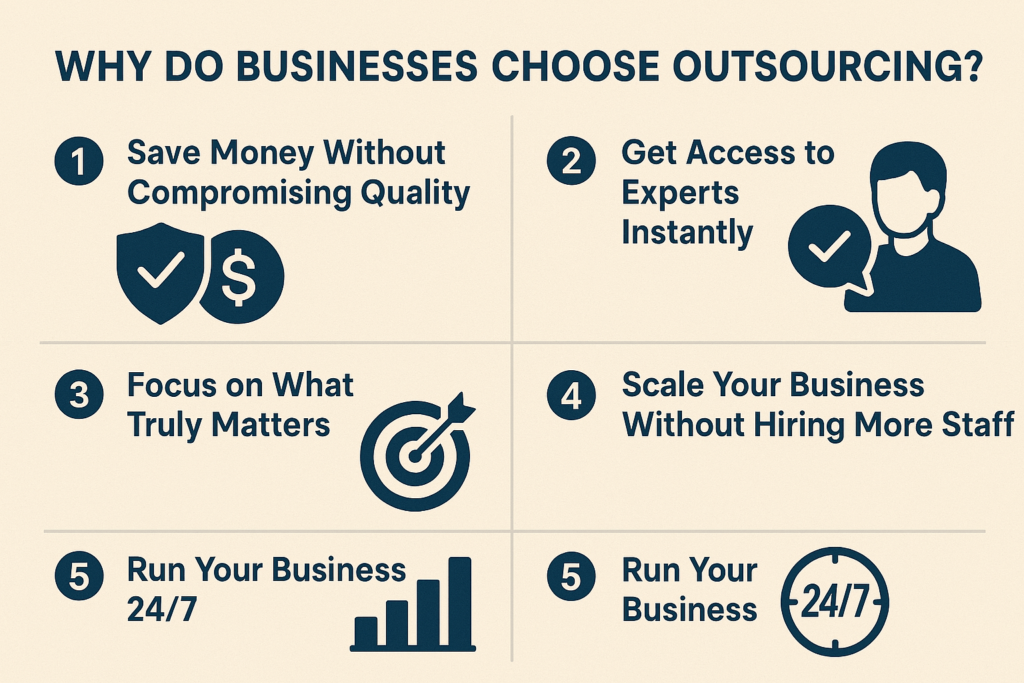
Here’s why outsourcing makes sense for companies of all sizes:
1. Save Money Without Compromising Quality
Hiring full-time employees means paying salaries, benefits, and office expenses. Outsourcing eliminates these costs. Businesses get skilled professionals at a lower price, especially with offshore outsourcing. That’s why companies looking for cost-effective solutions turn to business process outsourcing (BPO) for tasks like customer service, data entry, and IT support.
2. Get Access to Experts Instantly
Some tasks require specialists—like software development, accounting, or digital marketing. Instead of spending months hiring and training an in-house team, companies outsource to professionals who already know the job. This is why outsourcing IT services, call center operations, and content writing is so popular.
3. Focus on What Truly Matters
Time is everything in business. If you’re spending hours managing payroll, handling customer complaints, or doing routine admin work, you’re not focusing on growth. Outsourcing takes care of these tasks so you can focus on strategy, sales, and innovation. That’s why many businesses rely on outsourcing back-office support, HR, and accounting services to stay efficient.
4. Scale Your Business Without Hiring More Staff
Business isn’t always predictable. There are busy seasons, slow months, and unexpected challenges. Outsourcing gives companies the flexibility to scale up or down without the hassle of hiring or firing employees. This is especially useful for outsourced customer support, virtual assistant services, and IT consulting.
5. Run Your Business 24/7
Customers expect quick responses, even outside office hours. By outsourcing to teams in different time zones, businesses ensure their operations continue round the clock. This is why many companies choose outsourced call centers, live chat support, and IT monitoring services to keep things running smoothly.
Outsourcing isn’t just about saving money. It’s about making smarter business decisions. In the next section, we’ll break down the different types of outsourcing and how each one can help businesses grow.
Common Challenges in Outsourcing (And How to Overcome Them)
Outsourcing has its benefits, but it also comes with challenges. Here’s how to handle them.
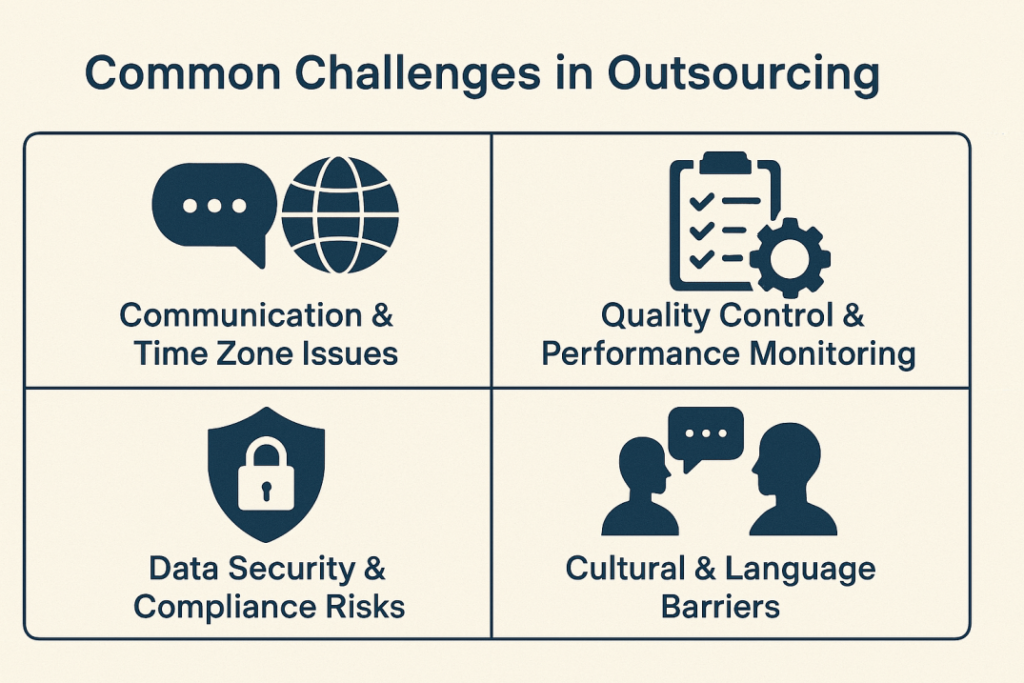
Communication & Time Zone Issues
Different time zones and unclear communication can slow projects down.
✔ Use Communication Tools: Slack, Zoom, and Microsoft Teams keep teams connected.
✔ Set Overlapping Hours: Ensure some working hours align for real-time discussions.
✔ Document Everything: Clear guidelines reduce confusion.
Example: A US-based SaaS company holds daily stand-ups with its European team to stay aligned.
Quality Control & Performance Monitoring
Without proper monitoring, work quality may suffer.
✔ Set Clear Goals: Define key performance indicators (KPIs) from the start.
✔ Review Regularly: Weekly or monthly check-ins ensure quality.
✔ Use Tracking Tools: Trello, Asana, and Monday.com help monitor progress.
Example: An ecommerce brand outsources content but uses Grammarly and plagiarism checkers to ensure quality.
Data Security & Compliance Risks
Sharing data with third parties comes with risks.
✔ Sign NDAs: Protect confidential information with legal agreements.
✔ Use Secure Platforms: Encrypted file-sharing and VPNs keep data safe.
✔ Limit Data Access: Only give access to what’s needed.
Example: A fintech company outsources software development but ensures developers work on a secure VPN.
Cultural & Language Barriers
Different work styles and language gaps can affect teamwork.
✔ Choose Culturally Aligned Teams: Work with vendors that understand your work culture.
✔ Use Simple Language: Avoid jargon and complex phrases.
✔ Provide Cultural Training: Help teams understand each other.
Example: A US company outsourcing customer support to the Philippines provides cultural training to improve communication.
What’s Next?
Now that you know the key challenges and how to overcome them, the next step is exploring the types of outsourcing and how they benefit businesses.
Types of Outsourcing and How They Benefit Businesses
Outsourcing helps businesses focus on what they do best. Instead of handling every task in-house, they hire experts to take care of specific jobs. This saves time, reduces costs, and improves efficiency. But outsourcing isn’t the same for everyone. Different businesses need different types of outsourcing.
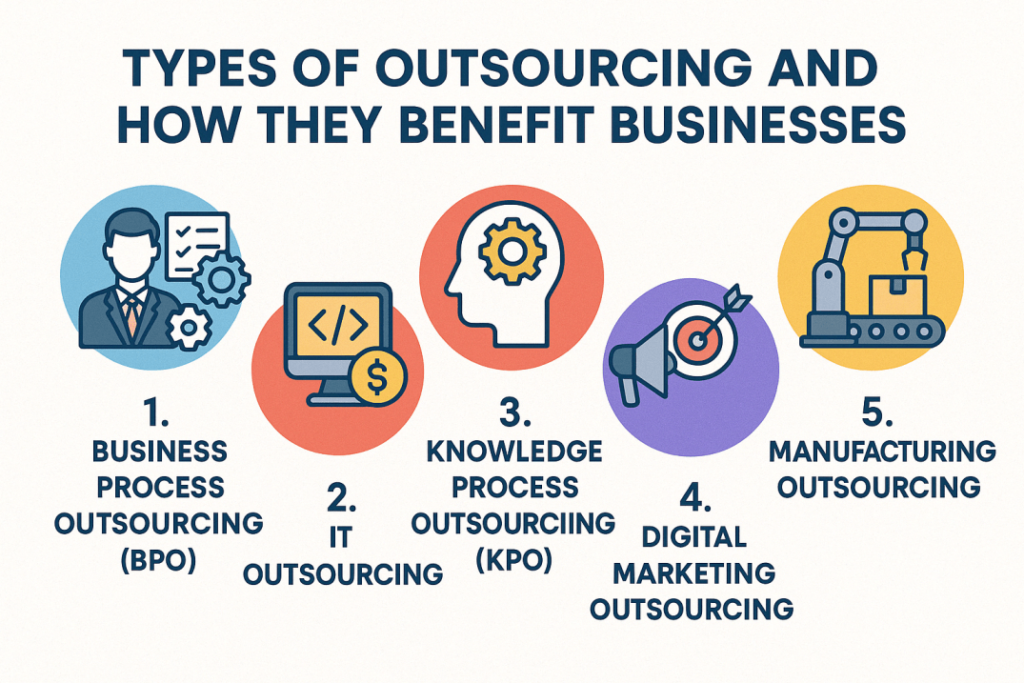
Let’s break it down.
1. Business Process Outsourcing (BPO)
Some tasks don’t need a full-time team. They just need to get done. That’s where business process outsourcing (BPO) comes in. Companies outsource everyday operations like:
- Customer support outsourcing – A third-party team handles phone calls, live chat, and emails.
- Data entry outsourcing – Businesses send bulk data processing, transcription, or form-filling work to external teams.
- HR and payroll outsourcing – A service provider manages recruitment, payroll, and compliance.
Why businesses choose BPO: It saves time, reduces hiring costs, and ensures tasks get done right.
2. IT Outsourcing
Tech is a big deal. But not every company can afford a full IT team. IT outsourcing helps businesses get expert help without hiring in-house. This includes:
- Software development outsourcing – Companies hire external developers to build apps, websites, and custom software.
- IT support outsourcing – A remote team handles system maintenance, troubleshooting, and security updates.
- Cybersecurity outsourcing – Businesses rely on security experts to protect data and prevent cyber threats.
Why IT outsourcing works: It’s cost-effective, provides access to skilled experts, and ensures up-to-date technology.
3. Knowledge Process Outsourcing (KPO)
Some businesses need more than just routine tasks—they need expertise. That’s where knowledge process outsourcing (KPO) comes in. It covers:
- Market research outsourcing – Experts analyze competitors, trends, and customer behavior.
- Financial analysis outsourcing – Businesses get help with forecasting, budgeting, and risk assessment.
- Legal process outsourcing (LPO) – Law firms and companies outsource contract reviews, compliance, and case research.
Why KPO matters: It provides expert-level insights without hiring expensive specialists.
4. Digital Marketing Outsourcing
Marketing is essential, but it takes time. Outsourcing digital marketing helps businesses stay visible without building a full in-house team. This includes:
- SEO outsourcing – Agencies handle keyword research, link building, and on-page optimization.
- Content marketing outsourcing – Writers create blogs, social media posts, and email campaigns.
- PPC campaign outsourcing – Experts manage Google Ads, Facebook Ads, and paid social media campaigns.
Why businesses outsource marketing: It increases brand visibility, improves ROI, and brings in more customers.
5. Manufacturing Outsourcing
Building products in-house is expensive. That’s why many companies use manufacturing outsourcing to reduce costs and speed up production. This includes:
- Contract manufacturing – A third-party factory produces goods under a company’s brand.
- Supply chain outsourcing – Businesses hire logistics providers to manage inventory and shipping.
- OEM outsourcing – Brands partner with manufacturers to create parts or entire products.
Why companies outsource manufacturing: It lowers production costs, speeds up delivery, and allows businesses to scale.
Each type of outsourcing helps businesses grow in different ways. The key is choosing the right one. In the next section, we’ll look at the pros and cons of outsourcing so businesses can make informed decisions.
Pros and Cons of Outsourcing
Outsourcing helps businesses cut costs and work faster. But it also has risks. Before making a decision, companies need to weigh the pros and cons carefully.
Let’s break it down.
| Pros of Outsourcing | Details | Cons of Outsourcing | Details |
| ✅ Cost Savings | Hiring full-time employees is expensive. Businesses need to pay salaries, benefits, and office space costs. Outsourcing reduces operational expenses by allowing companies to pay only for the services they need. | ❌ Less Control | Since an external provider handles the work, businesses have less direct control over outsourced processes. This can lead to quality inconsistencies if not managed properly. |
| ✅ Access to Experts | Some tasks require specialized skills. Instead of spending time and money on training employees, companies can outsource to skilled professionals who already have the right experience. | ❌ Quality Risks | Not all outsourcing providers maintain the same level of quality. Choosing the wrong outsourcing company can lead to poor service, missed deadlines, and customer dissatisfaction. |
| ✅ Focus on Core Business | Handling everything in-house slows growth. Outsourcing non-core tasks allows businesses to concentrate on their core competencies and improve overall efficiency. | ❌ Communication Barriers | Time zone differences, language barriers, and cultural differences can cause miscommunication in outsourcing partnerships, leading to delays and inefficiencies. |
| ✅ Faster Turnaround Time | Outsourcing providers have established systems and experienced teams. This helps businesses get work done faster than if they handled everything internally. | ❌ Hidden Costs | While outsourcing can be cost-effective, hidden expenses such as revisions, contract fees, or additional services can add up over time. |
| ✅ Scalability | Hiring and training employees takes time. Outsourcing offers flexibility by allowing businesses to scale up or down quickly without long-term commitments. | ❌ Security Risks | Sharing sensitive business data with an external provider increases the risk of data breaches or intellectual property theft if security measures are not in place. |
Key Takeaway
Outsourcing offers cost savings, scalability, and access to expertise, but it also comes with risks like less control and potential security concerns. The key to success is choosing the right outsourcing partner and setting clear expectations.
Choosing the Right Outsourcing Partner
Picking the right outsourcing vendor is a big decision. The wrong choice can lead to wasted time and resources. The right partner, however, can help your business grow efficiently. Here’s what to consider.
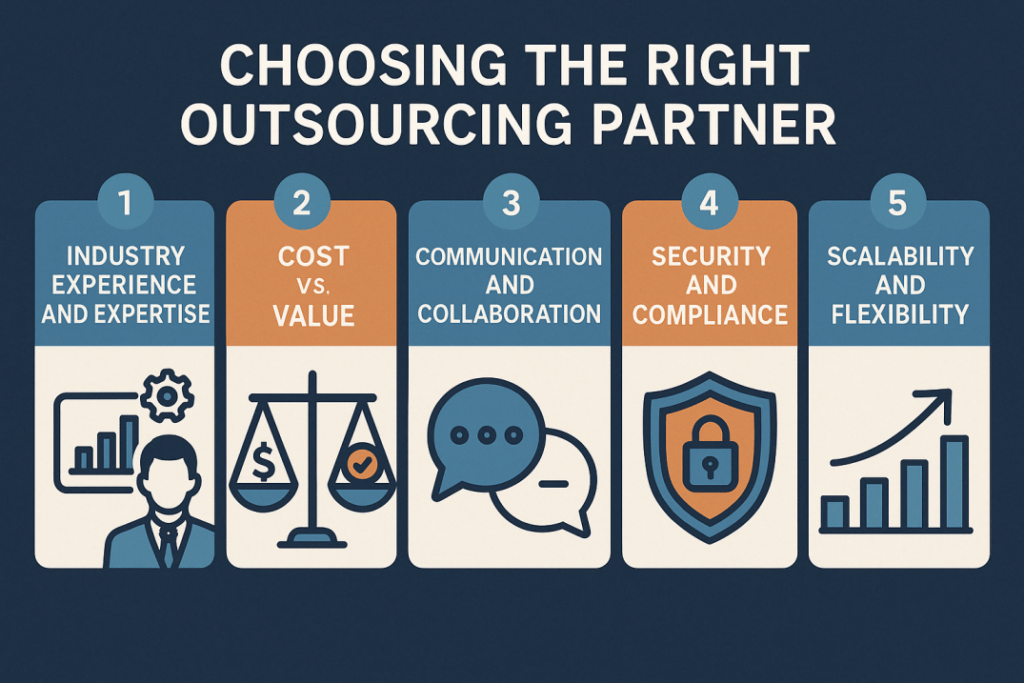
1. Industry Experience and Expertise
✔ Proven Track Record: Look for vendors with experience in your industry.
✔ Relevant Skills: Ensure they have the expertise needed for your tasks.
✔ Client Reviews & Case Studies: Check testimonials and past success stories.
Example: A SaaS company hiring a content marketing agency should choose one with experience in the software industry.
2. Cost vs. Value
✔ Transparent Pricing: Avoid vendors with hidden fees.
✔ Cost vs. Quality: The cheapest option isn’t always the best.
✔ Flexible Pricing Models: Look for hourly, project-based, or retainer options.
Example: A startup outsourcing customer service should balance affordability with quality support.
3. Communication and Collaboration
✔ Clear Reporting: Regular updates and progress tracking are essential.
✔ Time Zone Compatibility: Ensure their working hours align with yours.
✔ Effective Tools: Look for vendors using Slack, Zoom, or Asana for collaboration.
Example: A US company working with an Indian IT firm should ensure overlapping work hours for real-time discussions.
4. Security and Compliance
✔ Data Protection Measures: Check if they follow security best practices.
✔ Legal Compliance: Ensure they adhere to industry regulations.
✔ Confidentiality Agreements: A strong NDA protects your sensitive data.
Example: A healthcare provider outsourcing data processing must ensure HIPAA compliance.
5. Scalability and Flexibility
✔ Room for Growth: Choose a vendor who can scale with your business.
✔ Adaptability: Ensure they can handle workload changes efficiently.
✔ Long-Term Partnership: Look for vendors committed to growth, not just short-term tasks.
Example: An e-commerce brand scaling operations should partner with a flexible logistics provider.
What’s Next?
Now that you know what to look for in an outsourcing partner, let’s go on how to outsource work and get the best results successfully.
Step-by-Step Guide to Outsourcing Successfully
Outsourcing works best when done the right way. Follow these steps to make sure you get the results you need.
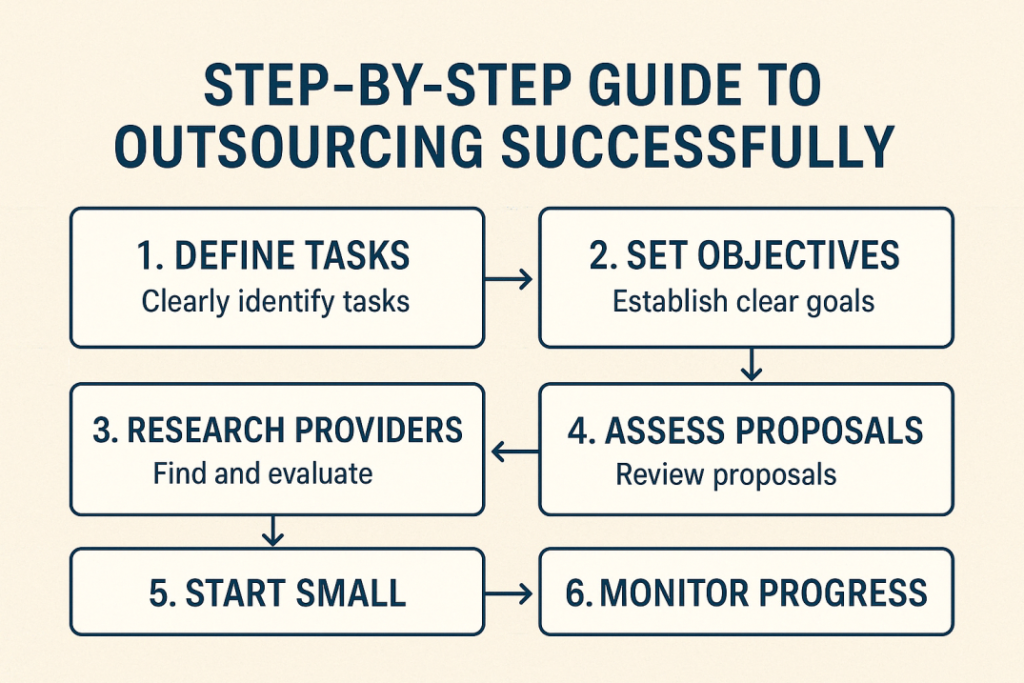
1. Identify Tasks to Outsource
✔ List Repetitive Tasks: These take up time but don’t need your direct involvement.
✔ Identify Skill Gaps: Outsource work that requires expertise you don’t have.
✔ Focus on Growth: Free up time for core business activities.
Example: A startup can outsource customer support to focus on product development.
2. Set a Budget and Choose a Pricing Model
✔ Decide Your Budget: Know what you can afford to spend.
✔ Compare Pricing Models: Choose between hourly, fixed, or performance-based pricing.
✔ Check for Hidden Costs: Some vendors charge extra for revisions or urgent work.
Example: A company outsourcing graphic design can opt for a fixed-price model per project.
3. Find and Hire the Right Team
✔ Compare Vendors: Look at experience, reviews, and case studies.
✔ Conduct Interviews: Test their skills with a small task if needed.
✔ Check Communication Skills: Ensure smooth collaboration before finalizing.
Example: A business hiring a virtual assistant should ensure clear communication and responsiveness.
4. Onboard and Set Clear Expectations
✔ Provide Detailed Guidelines: Share workflows, brand style guides, and goals.
✔ Set KPIs: Define success with measurable targets.
✔ Use Project Management Tools: Keep work organized with Trello, Asana, or ClickUp.
Example: A marketing agency outsourcing blog writing should provide content briefs and SEO guidelines.
5. Monitor Performance and Optimize
✔ Track Work Progress: Get regular updates and reports.
✔ Give Feedback: Ensure quality by reviewing work and suggesting improvements.
✔ Adjust When Needed: Optimize processes for better efficiency.
Example: A business outsourcing social media management should track engagement metrics and adjust strategies.
What’s Next?
Now that you have a process in place, let’s look at the best tools to manage remote teams efficiently.
Best Tools & Platforms for Managing Remote Teams
Managing an outsourced team requires the right tools. These platforms help with communication, project tracking, and productivity.
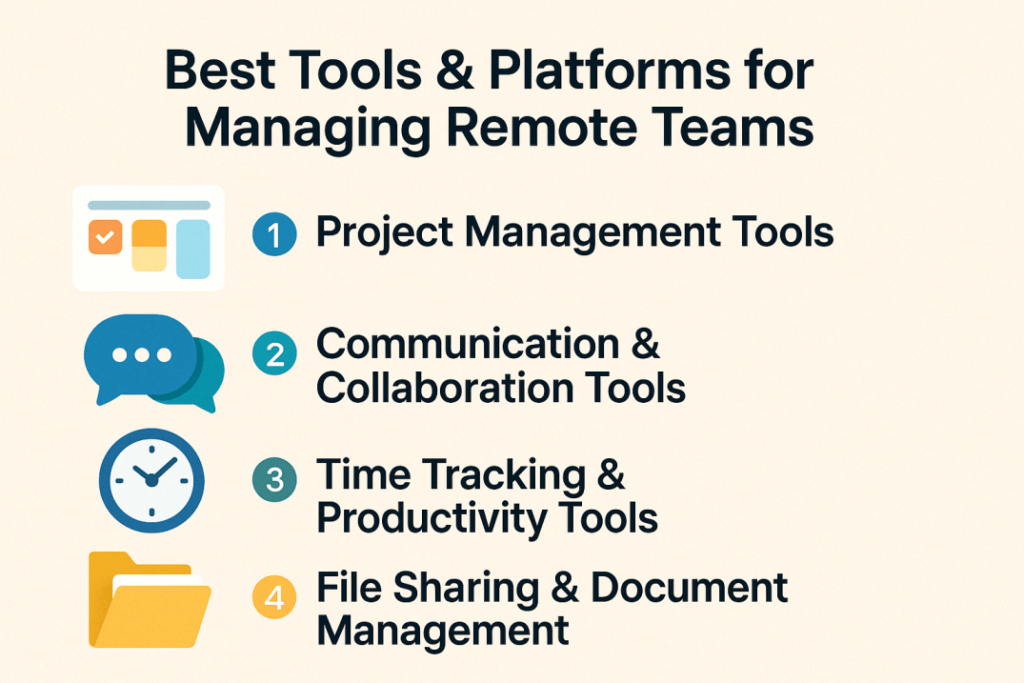
1. Project Management Tools
✔ Trello – Simple drag-and-drop task management.
✔ Asana – Organizes tasks, deadlines, and team responsibilities.
✔ Monday.com – Customizable workflows for various business needs.
Example: A marketing agency outsourcing content writing can use Asana to track blog deadlines and revisions.
2. Communication & Collaboration Tools
✔ Slack – Instant messaging and organized team channels.
✔ Zoom – Video calls and webinars for clear discussions.
✔ Microsoft Teams – Integrates chat, meetings, and file sharing.
Example: A company outsourcing customer support can use Slack for quick communication between remote agents.
3. Time Tracking & Productivity Tools
✔ Time Doctor – Tracks work hours and productivity.
✔ Hubstaff – Monitors work with screenshots and reports.
✔ Toggl – Simple time tracking for freelancers and teams.
Example: A business outsourcing software development can use Hubstaff to ensure remote developers are on track.
4. File Sharing & Document Management
✔ Google Drive – Cloud storage for easy access and sharing.
✔ Dropbox – Secure file storage with team collaboration.
✔ Notion – All-in-one workspace for notes, tasks, and databases.
Example: A design agency outsourcing branding work can use Google Drive to share brand assets and revisions.
What’s Next?
With the right tools in place, let’s explore real-world examples of how companies have successfully outsourced their work.
Case Studies: How Companies Successfully Outsourced Work
Outsourcing has helped businesses grow faster and cut costs. Here are real examples of companies that scaled with outsourcing.
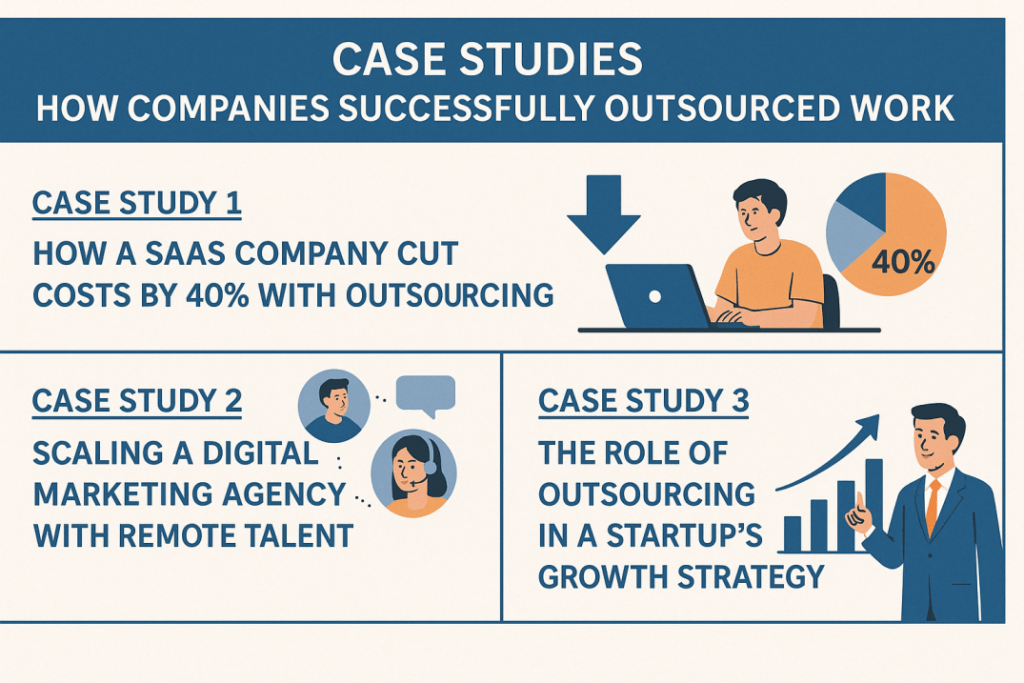
Case Study 1: How a SaaS Company Cut Costs by 40% with Outsourcing
A mid-sized SaaS company struggled with high development costs. Hiring in-house developers was expensive. They outsourced software development to a skilled offshore team.
Results:
✔ 40% cost savings on salaries and office expenses.
✔ Faster software updates and better customer experience.
✔ Access to a larger pool of experienced developers.
Case Study 2: Scaling a Digital Marketing Agency with Remote Talent
A growing marketing agency needed content writers, designers, and PPC experts. Instead of hiring locally, they outsourced to freelancers and agencies worldwide.
Results:
✔ Increased content production without raising overhead costs.
✔ More flexibility to scale up or down based on demand.
✔ Access to niche skills like SEO and paid advertising.
Case Study 3: The Role of Outsourcing in a Startup’s Growth Strategy
A startup wanted to launch a mobile app but had a limited budget. They outsourced design, development, and customer support.
Results:
✔ Faster time to market with expert teams.
✔ Lower hiring and infrastructure costs.
✔ More focus on growth, partnerships, and fundraising.
What’s Next?
Outsourcing has transformed businesses worldwide. Now, let’s look at future trends shaping the outsourcing industry.
The Future of Outsourcing: Trends & Predictions
The outsourcing industry is evolving. Businesses are adapting to new trends to stay competitive. Here’s what the future looks like.
Rise of AI & Automation in Outsourcing
Artificial intelligence (AI) and automation are changing outsourcing. Routine tasks like customer support, data entry, and even content writing are now handled by AI.
Impact on Businesses:
✔ Lower costs by reducing manual work.
✔ Faster and more accurate task completion.
✔ Focus on hiring for complex and creative tasks.
Growth of Nearshore & Offshore Outsourcing Models
Companies are outsourcing closer to home (nearshoring) or to offshore teams in low-cost regions. Businesses want a balance between cost savings and smooth communication.
Why It Matters:
✔ Nearshoring reduces time zone and cultural gaps.
✔ Offshore outsourcing remains the most cost-effective.
✔ Hybrid models are becoming popular.
Increasing Demand for Specialized Remote Talent
Businesses are looking for experts in AI, cybersecurity, blockchain, and digital marketing. Outsourcing firms are focusing on hiring specialized professionals.
What to Expect:
✔ Higher demand for niche skills.
✔ More outsourcing firms offering specialized services.
✔ Increased salaries for high-demand roles.
What’s Next?
Outsourcing is evolving fast. But is it the right strategy for your business? Let’s sum up the pros and cons before you decide.
Final Thoughts: Is Outsourcing Right for Your Business?
Outsourcing has its benefits and challenges. Before making a decision, it’s important to weigh both sides.
| Pros & Cons Summary | ||
| Aspect | Pros | Cons |
| Cost | Lower labor and operational costs. | Hidden fees and quality issues may arise. |
| Talent | Access to global expertise. | Language and cultural barriers can slow processes. |
| Scalability | Scale operations up or down easily. | Requires careful planning and management. |
| Focus | Frees up internal teams for strategic tasks. | Losing control over outsourced processes is a risk. |
| Efficiency | Faster project completion with dedicated experts. | Quality varies based on the outsourcing partner chosen. |
Actionable Next Steps for Businesses Considering Outsourcing
If you’re ready to outsource, here’s what to do next:✔ Identify the right tasks to outsource – Start with non-core activities.
✔ Set clear expectations – Define goals, KPIs, and communication methods.
✔ Choose the right partner – Evaluate vendors based on experience and reviews.
✔ Start small – Test with a pilot project before full-scale outsourcing.
✔ Monitor and adjust – Regularly review performance and optimize processes.
1. Is outsourcing really cost-effective, or does it come with hidden costs?
Yes, outsourcing reduces costs, but hidden expenses can arise. These include management overhead, training, contract setup fees, and quality control efforts. Choosing the right outsourcing partner and setting clear expectations can help avoid surprises.
2. How do I ensure the quality of work when outsourcing?
Quality control is a major concern. Always check the vendor’s past work, set clear KPIs, and use project management tools like Trello or Asana. Regular performance reviews and feedback loops help maintain high standards.
3. What are the biggest risks of outsourcing, and how can I mitigate them?
The biggest risks include communication gaps, security breaches, and lack of accountability. To mitigate these, choose vendors with strong security policies, establish clear contracts, and use collaboration tools like Slack or Microsoft Teams.
4. How do I choose between freelancers, agencies, and dedicated remote teams?
Freelancers are cost-effective for small projects, agencies offer structured expertise, and dedicated teams provide long-term support. The right choice depends on your business needs and budget.
5. Will my business lose control over operations if I outsource?
Outsourcing doesn’t mean losing control. A structured process, clear reporting, and performance tracking tools help you maintain oversight while benefiting from external expertise.
6. How can I build trust with an outsourced team in a different country?
Trust comes from transparency, regular communication, and clear expectations. Daily check-ins, cultural understanding, and structured workflows ensure smooth collaboration.
7. What industries benefit the most from outsourcing?
Industries like IT, customer service, eCommerce, marketing, and finance benefit significantly. Any business looking to scale efficiently can leverage outsourcing.
8. How do I protect my data when outsourcing work?
Sign NDAs, work with vendors who follow GDPR or HIPAA compliance, and use secure collaboration tools. Always have clear data protection policies in place.
9. What if my outsourced team is in a different time zone? Won’t that create delays?
Time zone differences can be an advantage if managed well. Use overlapping work hours, asynchronous communication methods, and scheduling tools to keep workflows smooth.
10. Should startups outsource, or is it better to build an in-house team?
Startups can benefit from outsourcing by reducing costs and accessing specialized skills. However, core functions that define your brand and culture should remain in-house.





No Comment! Be the first one.